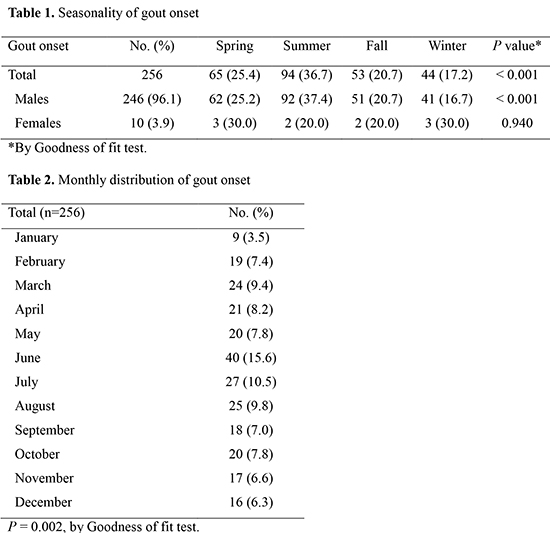1. Schlesinger N, Gowin KM, Baker DG, Beutler AM, Hoffman BI, Schumacher HR Jr. Acute gouty arthritis is seasonal. J Rheumatol. 1998; 25:342–344.
2. Gallerani M, Govoni M, Mucinelli M, Bigoni M, Trotta F, Manfredini R. Seasonal variation in the onset of acute microcrystalline arthritis. Rheumatology (Oxford). 1999; 38:1003–1006.
3. McLeod J. Gout and fibrositis in cold weather. Med J Aust. 1972; 1:943.
4. Arber N, Vaturi M, Schapiro JM, Jelin N, Weinberger A. Effect of weather conditions on acute gouty arthritis. Scand J Rheumatol. 1994; 23:22–24.
5. Elliot AJ, Cross KW, Fleming DM. Seasonality and trends in the incidence and prevalence of gout in England and Wales 1994-2007. Ann Rheum Dis. 2009; 68:1728–1733.
6. Schlesinger N. Acute gouty arthritis is seasonal: possible clues to understanding the pathogenesis of gouty arthritis. J Clin Rheumatol. 2005; 11:240–242.
7. Kumari R, Nath B, Midha T, Vaswani ND, Lekhwani S, Singh B. Morbidity profile and seasonal variation of diseases in a primary health center in kanpur district: a tool for the health planners. J Family Med Prim Care. 2012; 1:86–91.
8. Lee CH, Sung NY, Lee J, Bae SC. Factors associated with gout in South Koreans: analysis using the National Health Insurance Corporation and the National Health Screening Exam databases. Clin Rheumatol. 2013; 32:829–837.
9. Wallace SL, Robinson H, Masi AT, Decker JL, McCarty DJ, Yü TF. Preliminary criteria for the classification of the acute arthritis of primary gout. Arthritis Rheum. 1977; 20:895–900.
10. Gaffo AL, Schumacher HR, Saag KG, Taylor WJ, Dinnella J, Outman R, Chen L, Dalbeth N, Sivera F, Vázquez-Mellado J, et al. Developing a provisional definition of flare in patients with established gout. Arthritis Rheum. 2012; 64:1508–1517.
11. Williamson CS. Gout: a clinical study of one hundred and sixteen cases. JAMA. 1920; 74:1625–1629.
12. Punzi L, Salvati GP, Gambari PF. Seasonal variations in the frequency and synovial fluid inflammation in acute gout and pseudogout. J Rheumatol. 1999; 26:1642–1643.
13. Rovenský J, Mikulecký M, Masárová R. Gout and pseudogout chronobiology. J Rheumatol. 1999; 26:1426–1427.
14. Loeb JN. The influence of temperature on the solubility of monosodium urate. Arthritis Rheum. 1972; 15:189–192.
15. Guedj D, Weinberger A. Effect of weather conditions on rheumatic patients. Ann Rheum Dis. 1990; 49:158–159.
16. Fam AG. What is new about crystals other than monosodium urate? Curr Opin Rheumatol. 2000; 12:228–234.
17. Goldstein RA, Becker KL, Moore CF. Serum urate in healthy men. Intermittent elevations and seasonal effect. N Engl J Med. 1972; 287:649–650.
18. Arad Z, Marder J, Eylath U. Serum electrolyte and enzyme responses to heat stress and dehydration in the fowl (Gallus domesticus). Comp Biochem Physiol A Comp Physiol. 1983; 74:449–453.
19. Walker BR, Best R, Noon JP, Watt GC, Webb DJ. Seasonal variation in glucocorticoid activity in healthy men. J Clin Endocrinol Metab. 1997; 82:4015–4019.
20. King JA, Rosal MC, Ma Y, Reed G, Kelly TA, Stanek EJ 3rd, Ockene IS. Sequence and seasonal effects of salivary cortisol. Behav Med. 2000; 26:67–73.
21. Cardona F, Tinahones FJ, Collantes E, Escudero A, García-Fuentes E, Soriguer FJ. The elevated prevalence of apolipoprotein E2 in patients with gout is associated with reduced renal excretion of urates. Rheumatology (Oxford). 2003; 42:468–472.
22. Mak A, Ho RC, Tan JY, Teng GG, Lahiri M, Lateef A, Vasoo S, Boey ML, Koh DR, Feng PH. Atherogenic serum lipid profile is an independent predictor for gouty flares in patients with gouty arthropathy. Rheumatology (Oxford). 2009; 48:262–265.









 PDF
PDF ePub
ePub Citation
Citation Print
Print




 XML Download
XML Download